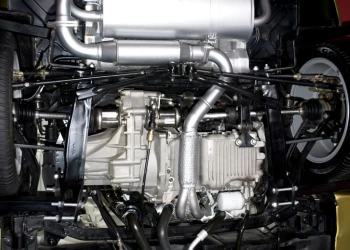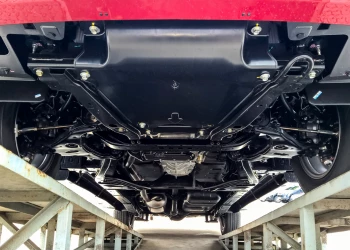Unleashing the power of Vehicle-to-Grid technology. Can we? Will we?
Add bookmarkIn the first of a series of exclusive articles, James Gordon explores the latest developments in V2G systems and asks if the technology has the power to reshape global electricity distribution networks.….
It is the world’s largest consumer of energy(1), and with over half of China’s 1.3 billion population choosing to live in its sprawling and gridlocked super-cities, the demand for power has never been greater. But ensuring that the 680 million who live in China’s megalopolises receive a steady stream of electricity is no easy task. However, while the solution – to install a network of long distance super-grids – has proved to be effective, it has come at great cost.
This highly innovative smart grid infrastructure that the State Grid Corporation of China, has been specially designed to transmit ultra-high-voltage-direct-current (UHVDC) at over 600,000 volts to China’s main population centres from rural areas rich in energy(2).
America, India, Germany and Brazil are also incorporating UHDVC lines into their grids, but Britain, whose population is expected to grow from 64,875,165 (2015) to 77,568,588 by 2050(3), is only in the early stages of exploring the potential of the technology according to the Energy Networks Association.
And while the UK’s Utility giants may yet decide to invest billions of pounds in these high-tech super grids, a fully functioning next-generation Battery Electric Vehicle to Grid (V2G) charging system, located in Birmingham, the UK’s second city, may mean they never need to.
But how could this potentially game-changing technology, which has been installed at Aston University’s European Bioenergy Research Institute (EBRI), one day save the National Grid and the tax-payer billions of pounds?
Says Dr Jin Yang, a lecturer in Power Engineering at Aston University, and a leading expert in electricity transmission distribution networks, “By 2025, KPMG has forecast that electric vehicles will out-sell internal combustion engine vehicles in the UK. In two decades’ time, each Battery Electric Vehicle (BEV) will have a power capacity of 7kWh. And with the UK government wanting every new car or van to be an ultra-low emission vehicle by 2040, it will be possible to harness the accumulated power from Britain’s sizeable BEV fleet to stabilise the grid system and address sudden energy shortfall. I strongly believe that if Utilities, OEMs, regulators and, most importantly drivers, buy-in to V2G technology, then it will postpone and possibly eliminate reinforcement of our electricity transmission and distribution infrastructure.”
It is a view shared by Dr Jim Scott, the co-founder and Chief Product Officer of Grid Edge Ltd., a technology start-up that specialises in applying Big Data and Artificial Intelligence (AI) to unconventional energy storage including V2G systems.
Says Scott, “The way we use energy is changing. The UK is transitioning from a mature grid which is largely centralised towards a more democratised, distributed and localised model. It will be about the system making better use of its existing assets. And this is where V2G can prove transformative.”
Scott continues, “By 2027, for example, Go Ultra Low (a UK government and industry low-emission motoring campaign) has forecast that more than half of all new cars could be electric vehicles. If the predictions prove to be correct, that would mean that 1.3 million new EVs will be sold on these islands every year. A very significant battery resource. If V2G captures the imagination of the OEMs, the DNOs, government and the motorist, and it becomes commonplace to allow the electricity in vehicles to provide support and flexibility into the grid, V2G suddenly becomes a very powerful concept which could bring about seismic change in the way we engage with the electricity system on a daily basis.”
V2G: Shovel-ready technology…
And for Scott, V2G isn’t an undeveloped and unrealised dream, it is real-world technology. A former research fellow at Aston University, Dr Scott is one of the architects of Europe’s first permanent and fully functioning V2G unit, which is housed at Aston University’s European Bioenergy Research Institute (EBRI).
At first glance, however, you could be forgiven for wondering what all the fuss is about. The single V2G unit, which cost less than UK£30,000 to install, looks like a standard charging point. But, there is one crucial difference.
Dr Scott explains. “This is one of the only systems in Europe, which not only allows the car owner to charge his or her vehicle, but also feed electricity into the EBRI building when it is required. So effectively the vehicle is a moveable battery store.”
So how does the technology work?
Says Scott, “The V2G unit consists of an AC/DC Bi-Directional inverter, which is connected to a CHAdeMO EV charge cable, and is also linked to the institute. The charging socket allows energy to flow into the vehicle, or alternatively to circulate from the vehicle into the building.
“On the building side of the V2G unit is an intelligent control algorithm which has been specifically designed to optimise in real-time when the V2G system should charge or discharge the vehicle, aiming to meet all the various building and vehicle demands for the lowest total cost.
“This algorithm works by making a prediction of the energy demand in the building, including how much power is needed to make the car ready for its next scheduled trip (we use the V2G unit to operate a pool car system). It updates its forecast every few hours but is continuously monitoring and optimising in real-time the control of the V2G unit. The algorithm then communicates with a control-unit housed in the V2G terminal which then initiates the appropriate response from the vehicle.
“The V2G technology that we have been demonstrating feeds into a wider R&D project, which totaled UK£1.1 million. The combination of intelligent control algorithms also ensure that the institute’s entire energy system is run at the lowest available cost. The new IP created around the control algorithms are being commercialised by Grid Edge.”
EBRI – a V2G trailblazer…
But Scott, who worked on this potentially ground-breaking technology for two years between 2013 and 2015, says that “the technology is in its infancy and has some limitations” which he is keen to spell out.
He explains, “The EBRI Building contains seven laboratories and eight offices. It has an average electrical load of 120kW, while the one V2G unit at EBRI can only deliver 10kW of power to the building. Therefore, in the event of an electricity outage, it wouldn’t be enough to restore power or stabilise the University’s micro-grid.”
So what exactly are the main benefits of the V2G system? Scott, who founded Grid-Edge in 2016 in a bid to further develop the technology by using artificial intelligence and big-data analytics, says,
Says Scott, “While V2G supplies 10 per cent of the EBRI building’s load and it is possible to charge a car using EBRI’s power output, the benefits are largely totemic at present. The technology was the first of its kind in in the UK, and right now it’s true value is to demonstrate an exciting vision of the future to visitors, whether they be from Distribution Network Operators, OEMs or from Utility companies.
[inlinead]
Scott continues, “When people come to see us – if they allow us to discharge the energy in their vehicles into the building – it enables us to showcase the palpable capabilities and potential of the technology of V2G. For example, many stakeholders come with the opinion that the large scale uptake of electric vehicles will create problems for the power system but we can show that, if dispatched properly, there is potential for EV’s to support rather than destabalise the grid.
“And with EV take-up set to mushroom in the next five to ten years, V2G infrastructure and the smart charging controls to go with it will become more widespread, the key will be to have all the different systems working together intelligently rather than either competing or being blind to the requirements and opportunities of the wider energy system around them.
V2G: how long before it makes a decisive impact?
So how long will it be before this pioneering technology, which could one day reduce electricity costs, becomes a standard feature in the e-mobility landscape?
Scott, believes that “addressing customer needs” is the most important driver to ensure mass take-up. “If the incentives can be aligned properly the market could grow quickly,” he says.
Continues Scott, “While Go Ultra Low’s tipping-point prediction for EVs is 2027, I believe that 2020 might actually be a water-shed moment for EV penetration because the direction of travel will be set. By then not only will EVs be quite prevalent, the details of how and when people charge will also have become clearer. Exactly how V2G and smart charging fit into that future deployment roadmap is up for grabs and the potential for new value creation is significant.
Robert Evans, the CEO of Cenex, the UK’s first Centre of Excellence for low carbon and fuel cell technologies Cenex, says V2G has the potential to make a sizeable impact in line with EV uptake.
Evans, whose consultancy is currently working on six V2G projects including the ITHECA and SEEV4-City projects, says,
“Projections for Ultra-Low Emission Vehicles (ULEV) uptake suggest by 2030 as much as 40 per cent of new cars will be an ULEV, meaning managed charging or V2G could represent a significant benefit to the electricity grid. It is anticipated that a proportion of the EVs deployed across the UK will engage with either smart charging or V2G services. However, the number is still to be estimated.”
But, Dr Jin Yang, who graduated at the prestigious China Electric Power University and has been lecturing in Power Engineering at Aston University for five years “believes that it won’t be until 2040, that we as a society, will be able to harness V2G’s true potential”.
Dr Yang explains, “Before 2040, V2G should not be thought of as a way of powering local grid networks all on its own, but a device for Distribution Network Operators (DNOs) to correct disparities in local grid demand.”
Yang, who worked in concert with Western Power Distribution Plc. on Project FALCON, an initiative which sought to assess the effect that low carbon technologies would place on the Milton Keynes grid, believes battery performance is stunting V2G growth.
“Currently EV batteries can deliver a relatively low capacity of kWh (20-200kWh) and, until the power rating increases from 3.5kW to 22 kW, V2G will, at best, only provide temporary power support to the grid. At 3.5 kW for instance, a V2G unit could possibly power your washing machine, but it certainly would not provide enough charge for a warm shower, which would require between 7.5 to 10 kW.
“So in terms of capability, EVs can possibly alleviate local distribution network issues, or – if a fleet of V2G equipped cars are parked and have sufficient power – collectively they may be able to feed power to the grid during black outs or periods of peak demand.”
V2G after 2040: A look at the future…
And after 2040?
Dr Yang says, “I believe that the future possibilities are very exciting, and once the necessary technologies are in place and correctly aligned, then I think it won’t just be a tool to restore local grid networks, but one which will primarily support largest swathes of the UK grid.
“If for example, V2G technology is employed in Britain’s super-car parks like the ones at Heathrow, Gatwick or Stansted airports, the results could be highly significant. Take Heathrow for example. Not only is it the UK’s largest airport, it is also one of the country’s largest car parks, which is vital to accommodate its 76,000 workforce and the 76 million passengers who used the facility last year.
“However, it is not just airports that will have a key role to play. The ports too could potentially supply large amounts of power to the grid. The Sheerness Car Import Dock, for example, from April 2015 to April 2016, handled 355,481 cars(4). In theory at least, and all caveats aside, this Kent port could potentially be another key energy hub.”
But Dr Yang, who is currently working on a Smart Grid infrastructure initiative with Western Power Distribution Plc., UK Power Networks (and also an EV project which is being funded by the Research Councils UK (RCUK) believes that the technology has another huge benefit.
“In the future, if a local area encounters an energy shortage, one solution proposed by DNOs is use to mobile generators to temporarily alleviate the problem. These are essentially huge car batteries, which are both cumbersome and expensive to transport. However, V2G will unlock the door to mobility, as the solution is found in car itself. So in theory, if the industry communicates and collaborates effectively, it ought to be possible to charge a fleet of EVs in one place where power is cheap and abundant, and then discharge that payload in a more remote location where power is scarce and expensive to access.”
V2G: the sums compute…
But how exactly does this bold vision of the future translate into the real world? Can Dr Yang who recently wrote a paper entitled, ‘Electric Vehicle Charging and Discharging Management Algorithm for a UK Low-Voltage Residential Distribution Network’, paint a detailed picture highlighting how the technology could prove to be a catalyst for massive change?
Dr Yang says, “Take the scenario, for instance. Imagine the Aston area in central Birmingham, which is home to around 32,000 people, is struck by a blackout at 10 pm.
“Now let’s assume that the nearby Yardley Wood Bus Depot, one of Birmingham’s largest hubs, is equipped with V2G infrastructure.
“For this event, we’ll presume, that while many of the buses are still carrying passengers on the city’s busy road networks, there are at least 30 fully charged vehicles parked in the terminus.
“Now assume that the discharging power rating of each bus’s battery is 300kW. That would mean that the fleet would be able to deliver 9,000kW into the grid in minutes. If the After Diversity Maximum Demand (ADMD) for an average house in Aston is 1-2kW, it would enable the 4,500 houses in Aston stay on the grid for half an hour or so, giving the DNOs precious time to restore power to the local area.”
“Post 2040, these EV fleets could be used to support autonomous communities to form self-sufficient micro-grids (with abundant renewable energy resources), which would not rely on the main grid.”
V2G: future challenges…
However, not everyone is as upbeat about the technology as Dr Yang. Cenex CEO, Robert Evans, prefers to take a more pragmatic approach when gauging if the technology will become a vital cog in Britain’s energy mix.
“Three key areas of development are required to ensure timely uptake of V2G in the UK: technology availability, identification of robust business cases and positive user perception. This is an ongoing process that is being facilitated by the UK Government and industry support,” he says.
Graham Evans, a leading automotive analyst at IHS Markit, believes that the current challenges outlined by Evans “currently outweigh the benefits”.
Speaking from his offices in central London, Evans, who worked as a powertrain engineer for both Jaguar and Bentley before joining IHS Markit in September last year, says,
“There are a myriad of obstacles that will need to be negotiated before V2G infrastructure is seen as a key contributor to the global energy mix. If V2G is to flourish, the major players – the DNOs, the Utilities and the OEMs - will have to step out of their comfort zones and collaborate in a way that they have never done before.
“Secondly, standards and regulations, which are non-existent at present will need to be developed, rubber-stamped and enacted.
“Thirdly, the V2G networks will not only need to be compatible with BEVs, but will also need to be reconcilable with the current charging infrastructure that is already being rolled-out across the world. This may not of course be possible and it might be that the industry will have to install upgraded Electric Vehicle Supply Equipment (EVSE).
“And perhaps most critical of all, the major stakeholders will need to educate, convince and financially incentivise the public to adopt V2G networks in their everyday lives. That is no easy sell.
“So I think we won’t see mass-adoption until 2030 at the very, very earliest and there is a strong possibility that the technology could encounter setbacks and delays, which could push that timeline ever further into the future.
“Finally, there are those too who think that V2G will never fly. A very knowledgeable and informed contact from a US EVSE, who I cannot name, for instance, recently told me that he thought that V2G would never be a financially viable technology and would remain a distant pipe dream.”
And meanwhile…
Back in Birmingham - Grid Edge – the company that Dr Jim Scott co-founded is having to adjust to change – but not a deviation in strategy or business case – just an office move - which he says “will allow the company to grow”.
Dr Scott, whose passion and belief in V2G technology remains undimmed, explains, “What sets V2G apart from other energy storage options is the tangible opportunity benefits it can deliver at a micro level. Increasingly it’s those distributed, behind the meter energy assets that are influencing the electricity system. At the interface between electricity and mobility it could be millions of motorists who embrace the technology and contribute to management of our distribution network.
“But, for the average person, it is not the highly complex algorithms and demand response technology that will make V2G a reality. Instead it is the humble automobile which will really sell the technology to the masses. Why? Because a car captures the imagination of a person in a way that other energy technologies cannot. Whether we like it or not, the car gives us the freedom of mobility that remains central to our society. And while we must address its many and complex constraints and limitations, V2G has the potential to write a new chapter for the automobile.”
It could be the most compelling passage yet…
References
(1)https://www.bp.com/content/dam/bp/pdf/energy-economics/statistical-review-2016/bp-statistical-review-of-world-energy-2016-full-report.pdf
(2)The Economist, January, 14th, 2017, Science and Technology, Rise of the supergrid, Page 73
(3)http://appsso.eurostat.ec.europa.eu/nui/show.do?query=BOOKMARK_DS-777262_QID_51EBD108_UID_-3F171EB0&layout=TIME,C,X,0;GEO,L,Y,0;UNIT,L,Z,0;AGE,L,Z,1;SEX,L,Z,2;INDICATORS,C,Z,3;&zSelection=DS-777262INDICATORS,OBS_FLAG;DS-777262UNIT,NR;DS-777262SEX,T;DS-777262AGE,TOTAL;&rankName1=TIME_1_0_0_0&rankName2=UNIT_1_2_-1_2&rankName3=GEO_1_2_0_1&rankName4=AGE_1_2_-1_2&rankName5=INDICATORS_1_2_-1_2&rankName6=SEX_1_2_-1_2&sortC=ASC_-1_FIRST&rStp=&cStp=&rDCh=&cDCh=&rDM=true&cDM=true&footnes=false&empty=false&wai=false&time_mode=NONE&time_most_recent=false&lang=EN&cfo=%23%23%23%2C%23%23%23.%23%23%23
(4)Statistic obtained from marketing department of Peel Ports Group Ltd.





















